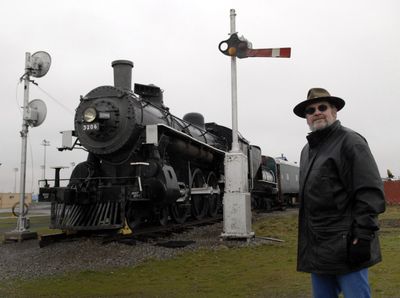Old locomotive brings grandeur of rails to life

For the first half of the 20th century, Union Pacific locomotive No. 3206 pulled cars carrying passengers throughout the Inland Northwest. Today, it stands at the head of a seven-car museum train at the Spokane County Fair & Expo Center.
During certain events at the fairgrounds, the museum train is open, and for $1 people can take a self-guided tour of the glory days of railroading.
In total, there are a dozen rail cars at the site, owned by the Inland Empire Railway Historical Society, adjacent to the society’s depot, which houses a lot of railroading memorabilia.
One cold morning recently, Eugene Hawk and John Simanton sat around the potbellied stove in the depot and gave the history of No. 3206, which they described as an early-modern locomotive, typical of passenger engines of the early 1900s.
No. 3206 was built by the American Locomotive Co., in Schenectady, N.Y., in 1904, and is a 4-6-2 steam Pacific-type locomotive. That designation comes from the wheel arrangement, which in the case of Pacific locomotives means four wheels for the leading truck that guides the locomotive, six driving wheels and a two-wheel tracking truck that supports the fire box.
Built to burn coal, it was converted to oil in the 1930s. The original owner was Oregon Railroad and Navigation, part of the Union Pacific family.
No. 3206 spent 50 years transporting passengers along branch lines mostly in Eastern Washington, north of Umatilla, Ore., through the Palouse and occasionally into North Idaho. In the early years, it was probably based in Tekoa, Hawk said, where there was a roundhouse and repair and maintenance facilities, and for a while the locomotive pulled freight trains on the Camas Prairie Railroad, a subsidiary of the Union Pacific and Northern Pacific lines.
With its 77-inch driving wheels, Hawk said there’s a rule of thumb that the diameter of the driving wheels plus 10 percent is the top speed of the locomotive.
This locomotive was retired to Pocatello, Idaho, in the 1950s, about the same time Union Pacific offered to donate a locomotive to the city of Spokane.
Hawk, who did signal maintenance for Union Pacific for 35 years, said a group from the city went down to Pocatello to look at locomotives and someone recognized No. 3206 as having been used in this area – and so the classic was chosen to return to Spokane. First located at High Bridge Park, it was donated by the city to the railway society in 1978 and moved to the fairgrounds. Simanton said the group – all volunteers – built tracks at the site, which connect to the old Milwaukee rail yard nearby.
Over the years, they have gathered additional cars – including a lunch counter car, Pullman car and others – and joined them into the museum train. They also operate a 2-foot-gauge train along an 800-foot loop during the Interstate Fair, offering rides for $2.
Steam was raised again in No. 3206 during the fair in September 1981, when the railroading society replaced much of the brass and copper piping and valves that had been vandalized during the High Bridge Park days. The whistle was restored, and for a short time, the emitted steam, looking and sounding like a working locomotive again.
Simanton, a retired Navy man who has loved railroading since he was a boy, said the railway society is working on building a rail museum on 30 acres west of Reardan and will move all the cars and memorabilia there within the next 10 years, after which the fairgrounds plans to expand its maintenance operation to the area where No. 3206 and the other rail cars sit.
“If we could raise the money and carry the insurance, there’s no reason not to put 3206 back in operation again,” Simanton said.
“We’d love to run her as an excursion train.”
That would be a railroader’s dream come true.